Knowing how to start a story so that your reader invests from page one is crucial to standing out. Make your preview pages work for your book sales with these ideas on how to hook readers, establish intriguing scenarios, and more from Chapter One:
How to start a story and get your reader to invest fast
To start your story with intrigue and page-turning questions:
- Hook towards what comes next
What questions will your reader want answered by paragraph two or three?
- Establish vivid scenarios
What tableau or scene will your reader have in their mind’s eye by the end of page one?
- Begin with dramatic mystery
What unknown will the start of your story tease or nod towards?
- Start stories with significant change
What cusp of change could your character be on at the start of their journey?
- Jump into emotional situations
What emotive situations drive your story forward from the start?
- Begin with a bold voice
Who is your narrator, telling the story? Are they involved in the action, and what is their personality?
- Make unknowns urgent
Why do your characters need to act now?
- Convey interesting context
What is interesting about the setting or the social or power dynamics of your world?
Let’s explore these ideas, with examples of strong starts from books:
Hook towards what comes next
What’s the first thing page one needs to do? Make your reader want to know what comes next.
What makes a good hook for a story?
- The hook makes your reader ask questions (who, what, why, where, or when)
- Hooks in first chapters often convey the story’s genre and themes (or hint towards them). A crime novel may begin with some detail alluding to the crime the story will solve, for example, or the broader context of law enforcement, crime and punishment (if approaching the subject slant)
- Hooks tend to contain the moment that everything changed – a body was found, or a plane’s wheels touched down on foreign ground
Examples of hooks starting stories
The bassist for the iconic post-punk band Joy Division, Peter Hook, begins the prologue of his memoir of the band with a double hook – alluding to a fight and a name-change:
Our first gig as Joy Division and it ended in a fight. Typical.
Peter Hook, Unknown Pleasures: Inside Joy Division (2012), p. xiv-xv
Not our first gig. Before that we’d been called Warsaw but, for reasons I’ll explain later, we couldn’t carry on being called Warsaw so we had to think of a new name.
This shows how to start a story with two curiosities. We wonder what led to the fight, and why the band rebranded from ‘Warsaw’ to ‘Joy Division’, so we keep reading.
Within this deceptively simple story opening, there are questions of who, what, and why: Who was in the fight, what started it, and why was changing the band’s name compulsory.
In a completely different genre, here is an example from Louise Penny’s Chief Inspector Armand Gamache mystery series:
“This doesn’t feel right, patron.” Isabelle Lacoste’s voice in his earpiece was anxious, verging on urgent.
Louise Penny, The Madness of Crowds: A Novel (2021), p. 3
Chief Inspector Gamache looked out over the roiling crowd, as the noise in the auditorium rose to a din.
A year ago a gathering of this sort would have not only been unthinkable, it would have been illegal.
Penny hooks the reader by throwing us straight into a situation that ‘doesn’t feel right’, creating suspense.
It achieves other useful things first pages do, such as hinting towards the broader context of the tense opening (a gathering in the wake of a pandemic – new territory with shifting rules).

Start with tools and support
Get tools to outline your story plus feedback from a constructive writing community.
START NOWEstablish vivid scenarios
Knowing ways to start a story so that the fundamental scenario is clear is useful. This will ensure your reader senses what your book is about from the first page (and thus knows why they should continue).
The examples above establish clear story scenarios.
The first suggests the story will explore the challenges of being in a band whose star is on the rise. The second nods to the period of intense change and rewritten rules following a pandemic.
To start your story with an intriguing scenario, ask:
- Who are the key characters in my story?
- What opening tableau or scene could suggest my story’s genre, themes, tone or mood?
- Do I want to begin by describing a place, a person, a situation, a conversation? How can I make this element create questions?
How to start stories with vivid scenarios: Example
Aminatta Forna’s The Memory of Love begins with a man in hospital, Elias Cole, telling a story to another man named Adrian.
See how simply Forna captures the hospital setting, describing the form of a man lying under a sheet:
On the iron-framed bed a single, scant sheet has moulded itself into the form of the human beneath. On top of the bedside cabinet a small pile of spiral-bound notebooks sits alongside a vase of flowers bright-coloured and plastic. The notebooks are worn from handling, the leaves rippled with damp. In the atmosphere of the room the memories of a man float and form. The man in the bed is telling a story. His name is Elias Cole.
Aminatta Forna, The Memory of Love (2010), p. 1
Forna supplies just enough descriptive detail to suggest place, launching mid-page into the story that Cole tells his audience, a psychologist named Adrian assigned to help him.
Context and key characters roll into one in a succinct beginning.
Begin with dramatic mystery
Mystery is the lifeblood of stories. Your story’s unknowns must be intriguing for your reader to want to continue. ‘What did Mary-Sue have for breakfast?’ is missing the ‘dramatic’ part of the equation. The part that makes stories good.
Mysterious beginnings tease your reader with questions such as:
- Why/how did the victim die?
- Why is the narrator bursting with excitement for this Saturday?
- Who was the person the girl saw reflected in the shop window who made her blood run cold?
Mysteries that matter tend to have strong emotions attached, be they joy, hopefulness and excitement, or dread and fear.
How to start a story off with mystery: Number9dream
David Mitchell begins his surreal coming-of-age meets detective story with a boy’s search for his father in Tokyo:
‘It is a simple matter. I know your name, and you knew mine, once upon a time: Eiji Miyake. Yes, that Eiji Miyake. We are both busy people, Ms Katō, so why not cut the small talk? I am in Tokyo to find my father. You know his name and you know his address. And you are going to give me both. Right now.’
David Mitchell, number9dream (2001), p. 3.
There is a propulsive sense of urgency to Eiji’s demand.
In addition to this dramatic quality, the opening raises multiple intriguing mysteries:
- Why did Ms Katō used to know Eiji’s name – why no longer?
- Why does Eiji need his father’s name (and address)? Are they estranged or has he never met him?
- How will Ms Katō respond to Eiji’s demand?
David Mitchell manages to pack several mysteries into one short opening paragraph.
Start stories with significant change
Many great stories start with significant change. The watershed moment where nothing will ever be the same again.
Types of change to start your story
Interesting types of change to begin your story with include:
- A character’s location (e.g. the missionary Price family in Barbara Kingsolver’s The Poisonwood Bible moving to the Congo)
- A person’s mind, feelings, status, belief or other previously static attribute
- A physical state or condition (for example Gregor’s transformation into a ‘monstrous vermin’ in Kafka’s Metamorphosis)
- The qualities of a place, society, or political system: For example, a sudden change in the power structures, security, peace, stability of a kingdom
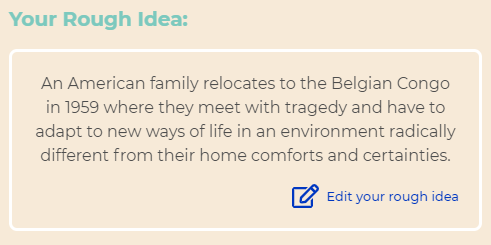
Change may be something shattering – a death or disability diagnosis, a humiliation, news of a betrayal. Or it might be a favorable change, something as simple as a dancer experiencing their first season on a major international stage, as in the example by Colum McCann below:
Example of starting a story with significant change: Colum McCann’s Dancer
Irish author Colum McCann begins his novel based on the life of the famous ballet dancer Rudolf Nureyev with a prologue about the objects thrown onto the dancer’s stage during his first season in Paris:
Paris 1961
What was flung onstage during his first season in Paris:
ten one-hundred franc bills held together with an elastic band;
Column McCann, Dancer (2003), p. 3.
a packet of Russian tea;
a manifesto from the Front de Libération National representing the Algerian nationalist movement, protesting the curfew imposed on Muslims after a series of car bombs in Paris; […]
This beginning is effective because the reader immediately sees:
- Context: The reader already has a good idea of ‘where’ and ‘when’ the story takes place, and that the story involves a performer and their character arc
- A character on the cusp of change: ‘What was flung onstage during his first season’ are brilliant starting words, implying movement, performance, and impact
The above example shows how a single, two-page prologue focused on a character’s (in this case, career) turning point can supply setting, context, background, initial drama and more.
Jump into emotional situations
Many first paragraphs are masterclasses in how to start a story off with an emotional or emotive situation.
Your opening pages might describe:
- A defining memory associated with an emotion such as fear, joy, nostalgia, anxiety, amusement, etc.
- An unfolding event that invokes strong emotions
- Conversation or dialogue filled with emotional subtext
Knowing how to start a story with heart gives readers something to connect with on an empathic or emotional level.
Starting with emotional situations: The Snow Queen
Michael Cunningham begins his novel The Snow Queen with a character being moved by a mysterious light in the sky in the midst of a breakup:
A celestial light appeared to Barrett Meeks in the sky over Central Park, four days after Barrett had been mauled, once again, by love. It was by no means his first romantic dropkick, but it was the first to have been conveyed by way of a five-line text, the fifth line of which was a crushingly corporate wish for good luck in the future, followed by three lowercase xxx’s.
Michael Cunningham, The Snow Queen (2014), p. 3.
Cunningham begins his novel with the banal way only a modern-day romance can end – a breakup via text message. This contrasts dramatically with the almost mystical experience that follows.
The emotional character of the situation gives us an immediate sense of Barrett’s feelings, his state of mind.
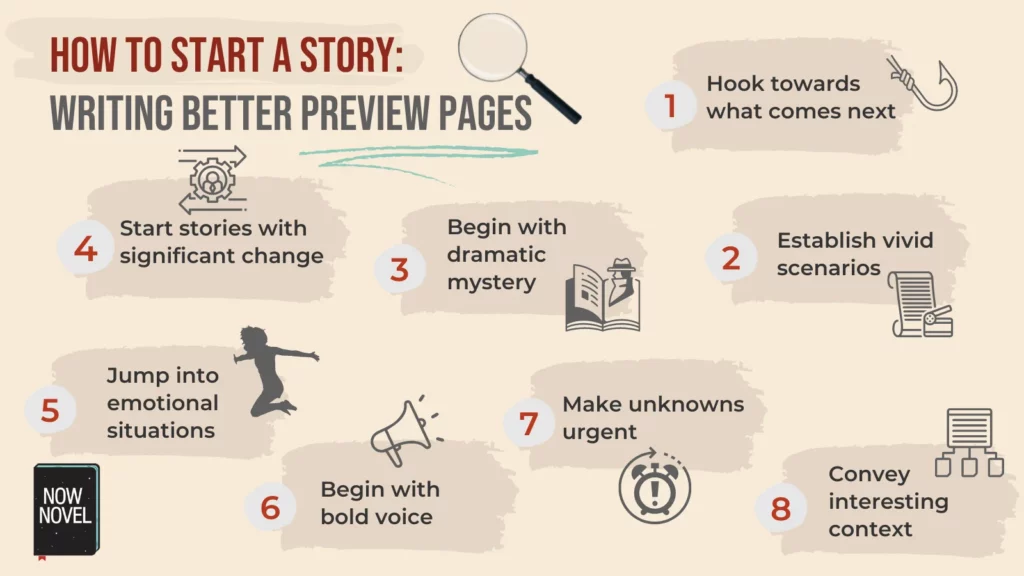
Begin with bold voice
Starting a story doesn’t necessarily need an explosive change or dramatic action.
The intrigue of your opening could be as simple as a compelling voice on the page.
Think of Holden Caulfield’s angry, sarcastic opening lines in J.D. Salinger’s The Catcher in the Rye:
If you really want to hear about it, the first thing you’ll probably want to know is where I was born, and what my lousy childhood was like, and how my parents were occupied and all before they had me, and all that David Copperfield kind of crap…
J.D. Salinger, Catcher in the Rye (1951), p. 5
To introduce your reader to a bold voice from your first paragraph, ask:
- What is my narrator’s emotional or mental state? Are they angry, jovial, sly, witty, pompous, excited, apprehensive?
- What is their world and outlook like? For example, in Holden’s opening narration, we get the sense he doesn’t rate fictional autobiography like Charles Dickens’ David Copperfield or his ‘lousy childhood’ very highly. The pessimistic tone is clear
Make unknowns urgent
You already know the key to hooking readers with the start of your story is making them want answers to unknowns.
Making said unknowns urgent ramps up the tension. A military evacuation doesn’t need to happen next month, but immediately, as in the story starting example below:
How to start a story with an urgent unknown: All the Light We Cannot See
Anthony Doerr’s Pulitzer-winning novel about World War Two begins with an emotional situation: an evacuation order being air-dropped to Paris (and its residents thus having to leave their beloved homes behind):
Leaflets
At dusk they pour from the sky. They blow across the ramparts, turn cartwheels over rooftops, flutter into the ravines between houses. Entire streets swirl with them, flashing white against the cobbles. Urgent message to the inhabitants of this town, they say. Depart immediately to open country.
Anthony Doerr, All the Light we Cannot See (2014), p. 3.
Doerr’s opening makes it clear impending action is urgent. It launches us immediately into dramatic unfolding events.
Convey interesting context
When we discuss how to start a story, it’s easy to focus on conflict. Ticking bombs and ‘Quick, get to ze chopper!’
Conflict isn’t the only propelling force, though. Stories are as much about connection. Connecting incident to incident, and person to person. Person to place.
Kinds of context you can use your opening paragraphs to establish include:
- Setting: Place, time and era, culture
- Tone and mood: Is the atmosphere dark and menacing, joyful and light, stiff and formal?
- Social: Is there a gender, political or other power dynamic at play in the unfolding scene?
How to start a story with context: The Hungry Tide
Amitav Ghosh begins his novel The Hungry Tide with a Delhi businessman, Kanai Dutt, being drawn to an enigmatic Indian-American girl on a train platform:
Kanai spotted her the moment he stepped onto the crowded platform: he was deceived neither by her close-cropped black hair, nor by her clothes, which were those of a teenage boy – loose cotton pants and an oversized white shirt.
Amitav Ghosh, The Hungry Tide (2004), p. 3.
Ghosh continues to build Kanai’s (and the reader’s) intrigue about the girl, as Kanai notes:
… the neatly composed androgyny of her appearance seemed out of place, almost exotic.
Ghosh, p.3.
Why would a foreigner, a young woman, be standing in a south Kolkata commuter station, waiting for the train to Canning?
Ghosh effectively builds a gendered, multicultural context. He starts his story off with an instant magnetic attraction between a local and an ‘outsider’. This creates a subtle note of tension, building narrative suspense and curiosity about who the woman is and how Kanai and the woman will interact further.
Start your story with writing tools to outline and support from a caring writing community. Let us know in the comments what your favorite story beginnings of all time are!

Join us for fresh weekly insights
Join our writing craft newsletter for weekly tips, community Q&As, fun writing surveys and more.

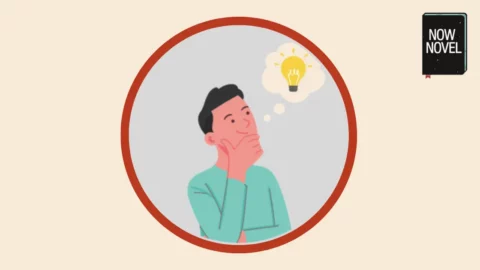
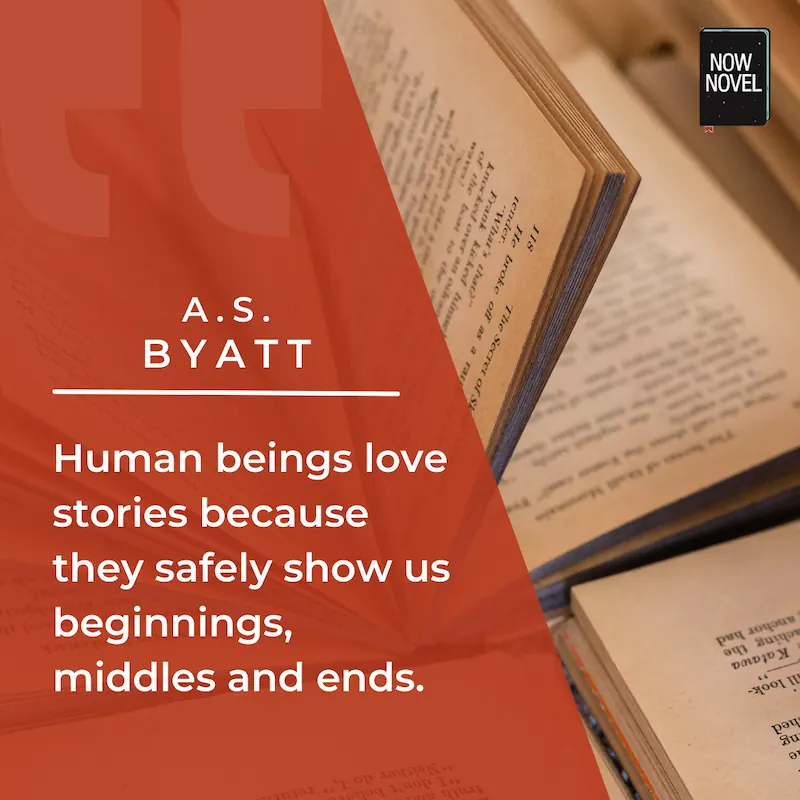
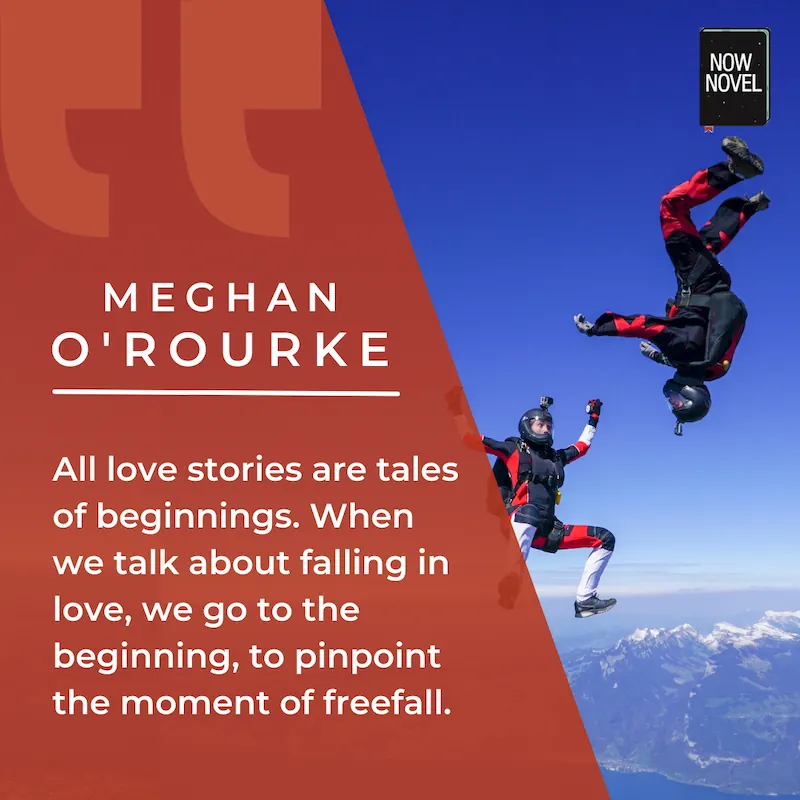
7 replies on “How to start a story: Writing better preview pages”
Story openings fascinate me, so thank you for this posting. My own YA work-in-progress begins: “The old gator needed killing.”
Hi Daniel, same here! Thank you for reading our blog and taking the time to comment. That’s a great first line, it had my attention immediately due to the implied conflict. Good luck with your YA-in-progress.
Great post. Beginnings are always difficult.
Thank you for your kind feedback, Vivienne, and for reading our blog. They are indeed! Drop us a line at [email protected] if you’d like any feedback on your own.
Thanks for these priceless tips. The mss I’m working on begins with this:
It was inscribed on her palm: Father was going to sell her. But sister could not sense anything at all.
That morning, my sister, Ghungroo, was counting 764 backwards beginning with 763, 762, 761… and her eyes moving over the flowers that stood freshly wilted the moment they had bloomed in the sunshine.
This article has valid points on how to begin a story; however, I mainly focus on beginning a fiction book with action and doing enough to keep the reader engaged and getting the sale from her/him.
Thank you for sharing that, Todd. I would say that falls under the first category of hooking your reader towards what comes next, since an action beat will usually necessitate some sort of reaction. Thank you for reading our blog and sharing your thoughts.